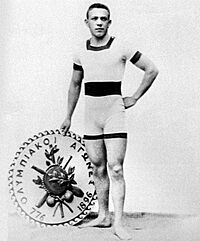Alfréd Hajós facts for kids

Hajós in Athens, 1896
|
|||||||||||||||||||||||||||||
| Personal information | |||||||||||||||||||||||||||||
|---|---|---|---|---|---|---|---|---|---|---|---|---|---|---|---|---|---|---|---|---|---|---|---|---|---|---|---|---|---|
| Birth name | Arnold Guttmann | ||||||||||||||||||||||||||||
| Nickname(s) | The Hungarian Dolphin | ||||||||||||||||||||||||||||
| Nationality | |||||||||||||||||||||||||||||
| Born | 1 February 1878 Budapest, Kingdom of Hungary |
||||||||||||||||||||||||||||
| Died | 12 November 1955 (aged 77) Budapest, Hungarian People's Republic Association football career
|
||||||||||||||||||||||||||||
| Sport | |||||||||||||||||||||||||||||
| Sport | Swimming | ||||||||||||||||||||||||||||
| Strokes | Freestyle | ||||||||||||||||||||||||||||
| Club | Magyar Testgyakorlók Köre | ||||||||||||||||||||||||||||
|
Medal record
|
|||||||||||||||||||||||||||||
Alfréd Hajós (born February 1, 1878 – died November 12, 1955) was an amazing Hungarian athlete and architect. He made history as the very first modern Olympic swimming champion. He was also the first Olympic champion ever from Hungary.
Hajós was good at many sports. He was a swimmer, a football (soccer) player, a referee, and even a coach for the national football team. Besides sports, he was a talented architect.
Contents
Becoming an Olympic Champion
Alfréd Hajós was born in Budapest, Hungary. His birth name was Arnold Guttmann. When he was 13, he decided to learn how to swim after a sad event involving his father and the Danube River. He later changed his name to Hajós, which means "sailor" in Hungarian, for his sports career.
In 1896, Hajós was studying architecture when the first modern Olympic Games were held in Athens, Greece. He got permission from his university to compete, but it wasn't easy! When he returned, his dean didn't even congratulate him on his Olympic success. Instead, the dean just wanted to know his answers for the next exam!
Swimming in the First Olympics
The swimming events at the 1896 Games were very tough. They took place in the cold Mediterranean Sea in the Bay of Zea. Athletes had to battle strong waves and cold water.
Hajós was only 18 years old. He won two gold medals in these difficult conditions. The water was about 13 degrees Celsius (55°F), and there were 4-meter (12-foot) waves! He won the 100-meter freestyle race in 1 minute and 22.2 seconds. He also won the 1,200-meter freestyle race in 18 minutes and 22.1 seconds. He was the youngest winner at those Athens Games.
Before the 1896 Olympics, Hajós was already a champion. He won the European 100-meter freestyle swimming title in both 1895 and 1896. His brother, Henrik Hajós, also won an Olympic gold medal later, in 1906, for swimming.
More Sports Achievements
Alfréd Hajós was a truly versatile athlete. He didn't just swim!
Track and Field
In 1898, he won Hungary's championship for the 100-meter sprint. He also won national titles in 400-meter hurdles and discus.
Football (Soccer) Player and Coach
Hajós also played football (soccer) as a forward. He played in Hungary's national championship between 1901 and 1903.
On October 12, 1902, he made history again. He was one of the eleven players in the first international match for the Hungarian national team. He was even the captain of his team in that game against Austria.
From 1897 to 1904, he was also a football (soccer) referee. In 1906, he became the coach of Hungary's national football team. He led the team in three games, with a record of two draws and one win.
Architecture Career
Alfréd Hajós was not only a sports hero but also a very successful architect. He specialized in designing sports facilities.
Olympic Medal in Art
In 1924, Hajós entered the art competitions at the Paris Olympic Games. He submitted a plan for a stadium, which he designed with Dezső Lauber. Their design won a silver medal! The judges didn't even give out a gold medal in that competition.
This made Hajós one of only two Olympians ever to win medals in both sports (swimming) and art (architecture) at the Olympics.
Famous Buildings
Hajós graduated from the Technical University of Budapest in 1899. After World War I, he started his own architecture business. Later, he helped rebuild many public buildings in Budapest and Hungary.
His most famous sports building is the Alfréd Hajós National Swimming Stadium. It's located on Margitsziget (Margaret Island) in Budapest. This stadium was built in 1930 and has been used for many big swimming events, including European Aquatics Championships. Today, the stadium is named after him!
His early designs used styles like Art Nouveau and eclectic. Later, he moved towards modernism, influenced by Italian styles.
- Hotel Aranybika, Debrecen
- Gymnasium of Janko Francisci - Rimavský, (Levoča, 1913)
- Protestant Church Centre, Budapest
- Újpest FC's UTE Stadium, Újpest, Megyeri ut (1922)
- Swimming Stadium, Budapest, Margitsziget (today it bears his name)
- Millenáris Sportpálya, Budapest XIV
- Sports ground, Miskolc
- Sports ground, Pápa
- Sports ground, Szeged
- Sports ground, Kaposvár
- Girls' School (Hungarian: III. állam polgári leányiskola Pozsonyban, Slovak: III. štátna meštianska škola dievčenská v Bratislave) 1914, Bratislava
- Népkert Vigadó, Miskolc, Népkert
- Swimbath, Szeged (Ligetfürdő, 1930)
Honors and Legacy
Alfréd Hajós received many honors for his amazing achievements.
In 1953, the International Olympic Committee gave him the Olympic Diploma of Merit. He is also a member of the International Swimming Hall of Fame. In 1981, he was added to the International Jewish Sports Hall of Fame. In 2010, after his death, he received the Ybl Miklós Prize, which is the highest honor for architects in Hungary.
Images for kids
-
Grand Hotel Aranybika (1915)
See also
 In Spanish: Alfréd Hajós para niños
In Spanish: Alfréd Hajós para niños
- List of members of the International Swimming Hall of Fame
- List of select Jewish swimmers



